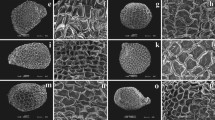Abstract
The seed morphology of 79 species of neotropical Miconieae (Melastomataceae) is presented. These species have been chosen, in majority, from the polyphyletic genus Leandra. A few other species from the polyphyletic genera Miconia, Ossaea, and Clidemia were also sampled, because of potential similarities. Sixteen morphological seed types are defined after analysis through light microscopy and scanning electron microscopy. The seed morphology appears to possess a great deal of variability on the level of the overall shape as well as the structure and the surface of the testa. The different types defined here do not match with genera or sections, but rather are composed of species coming from different genera. In comparison with a preliminary molecular phylogeny study done on Leandra, some types of seeds are related to well supported clades. In some cases seed morphology corresponds with natural groups of species, thus being of high phylogenetic importance.




Similar content being viewed by others
Literature Cited
Anderberg, A. L. 1994. Resedaceae-Umbelliferae. In: G. Berggren (ed.), Atlas of seeds and small fruits of Northwest-European plant species. (Sweden, Norway, Denmark, East Fennoscandia and Iceland) with morphological descriptions. Swedish Museum of Natural History, Stockholm 4: 1–281.
Barthlott, W. 1981. Epidermal seed surface characters of plants: systematic applicability and some evolutionary aspects. Nordic Journal of Botany 1: 345–355.
Bécquer-Granados, E. R., K. M. Neubig, W. S. Judd, F. A. Michelangeli, J. R. Abbott & D. S. Penneys. 2008. Preliminary molecular phylogenetic studies in Pachyanthus (Miconieae, Melastomataceae). Botanical Review: 74: 37–52.
Cameron, K. M. & M. W. Chase. 1998. Seed morphology of Vanilloid Orchids (Vanilloideae: Orchidaceae). Lindleyana 13: 148–169.
Clausing, G. & S. S. Renner. 2001. Molecular phylogenetics of Melastomataceae and Memecylaceae: Implications for character evolution. American Journal of Botany 88: 486–498.
Cogniaux, C. A. 1891. Mélastomatacées. In: A. de Candolle (ed.), Monographiae Phanerogamarum, 7: 1–1256.
Corner, E. J. H. 1976. The seeds of dicotyledons. Cambridge University Press, New York.
Cremers, G. 1986. Architecture végétative et structure inflorescentielle de quelques Melastomataceae guyanaises. In: ORSTOM (ed.), Collections travaux et documents 199: 1–148.
de Candolle, A. P. D. 1828. Mémoires sur la famille des Mélastomatacées. Prodromus systematis naturalis regny vegetabilis 3: 99–102.
Goldenberg, R. 2000. O genero Miconia Ruiz et Pavon. (Melastomataceae): I. Listagens analiticas, II. Revisao taxonomica da secao Hypoxanthus (Rich. Ex DC.) Hook. f. Ph.D. Thesis. Universidade estadual de Campinas. Campinas. 249 pp.
Groenendijk, J. P., F. Bouman & A. M. Cleef. 1996. An exploratory study on seed morphology of Miconia Ruiz et Pavon (Melastomataceae), with taxonomic and ecological implications. Acta Botanica Neerlandica 45: 323–344.
Judd, W. S. 1986. Taxonomic studies in the Miconieae (Melastomataceae) I. Variation in the inflorescence position. Brittonia 38: 150–161.
———. 1989. Taxonomic studies in the Miconieae (Melastomataceae) III. Cladistic analysis of axillary-flowered taxa. Annals of the Missouri Botanical Garden 76: 476–495.
——— & J. D. Skean Jr. 1991. Taxonomic studies in the Miconieae (Melastomataceae) IV. Generic realignments among terminal-flowered taxa. Bulletin of the Florida Museum of Natural History. Biological Sciences 36: 25–84.
Martin, C. V., D. P. Little, R. Goldenberg & F. A. Michelangeli. 2008. A phylogenetic evaluation of Leandra (Miconieae, Melastomataceae): a polyphyletic genus where the seeds tell the story, not the petals. Cladistics 24: 317–327.
Michelangeli, F. A. 2000. A Cladistic Analysis of the genus Tococa (Melastomataceae) based on morphological data. Systematic Botany 25: 211–234.
———. 2005. Tococa (Melastomataceae). Flora Neotropica Monographs 98: 1–114.
———, D. S. Penneys, J. Giza D. Soltis, M. H. Hills & J. D. Skean Jr. 2004. A preliminary phylogeny of the tribe Miconieae (Melastomataceae) based on nrITS sequence data and its implications on inflorescence position. Taxon 53: 279–290.
———, W. S. Judd, D. S. Penneys, J. D. Skean Jr., E. R. Becquer-Granados, R. Goldenberg & C. V. Martin. 2008. Multiple events of dispersal and radiation of the tribe Miconieae (Melastomataceae) in the Caribbean. Botanical Review 74: 53–77.
Murley, M. R. 1951. Seeds of the Cruciferae of northeastern North America. American Midland Naturalist 46: 1–81.
Renner, S. S. 1990. A revision of Rhynchantera (Melastomataceae). Nordic Journal of Botany 9: 601–630.
———. 1994. A revision of Pterolepis (Melastomataceae: Melastomeae). Nordic Journal of Botany 14: 73–104.
———. 2004. Bayesian analysis of combined chloroplast loci, using multiple calibrations, supports the recent arrival of Melastomataceae in Africa and Madagascar. American Journal of Botany 91: 1427–1435.
Stearn, W. T. 2004. Botanical Latin. Fourth ed. Timber press, Portland.
Zhang, Z. H., D. Z. Yang, A. M. Lu & S. Knapp. 2005. Seed morphology of the tribe Hyoscyameae (Solanaceae). Taxon 54: 71–83.
Whiffin, T. & A. S. Tomb. 1972. The systematic significance of seed morphology in the neotropical capsular-fruited Melastomataceae. American Journal of Botany 59: 411–422.
Wurdack, J. J. 1980. Melastomataceae. In: G. Harling and B. Sparre (eds.). Flora of Ecuador 13: 1–406. University of Goteborg, Swedish Natural Science Research Council, Stockholm.
———. 1987. Notes on Melastomataceae of the Guianas. Brittonia 39: 159–164.
———, T. J. Morley & S. S. Renner. 1993. Melastomataceae. In: A. R. A. Görts-van Rijn (ed.). Flora of the Guianas 99: 1-425. Koeltz Scientific Books. Koenigstein.
Acknowledgments
We thank the Annette Kade Foundation for financial support to CVM while at NYBG, Lisa Campbell for able assistance with SEM and light microscope, and Tatyana Lobova for her helpful bibliographic information. This research was partially funded by NSF (DEB-0515665 to FAM). Special thanks to two anonymous manuscript reviewers for their judicious and very helpful comments.
Author information
Authors and Affiliations
Corresponding author
Appendix
Appendix
List of the species, with their current section placement, listing with the collector name and specimen number from The New York Botanical Garden Herbarium (NY)
Rights and permissions
About this article
Cite this article
Martin, C.V., Michelangeli, F.A. Comparative seed morphology of Leandra (Miconieae, Melastomataceae). Brittonia 61, 175–188 (2009). https://doi.org/10.1007/s12228-008-9060-x
Published:
Issue Date:
DOI: https://doi.org/10.1007/s12228-008-9060-x




